Travel Editor Patricia Garcia-Gomez Talks to Fellow Adventurist Alain Schroeder
We don’t know about you, but our grandmothers don’t spend their days in a wetsuit. Nor can they hold their breath underwater for two minutes. We are so inspired by this exquisite body of work by photojournalist Alain Schroeder that we just had to speak with him. Both about his work and how he has masterminded a life that allows him to travel the world and have a meaningful (and award winning) second career.
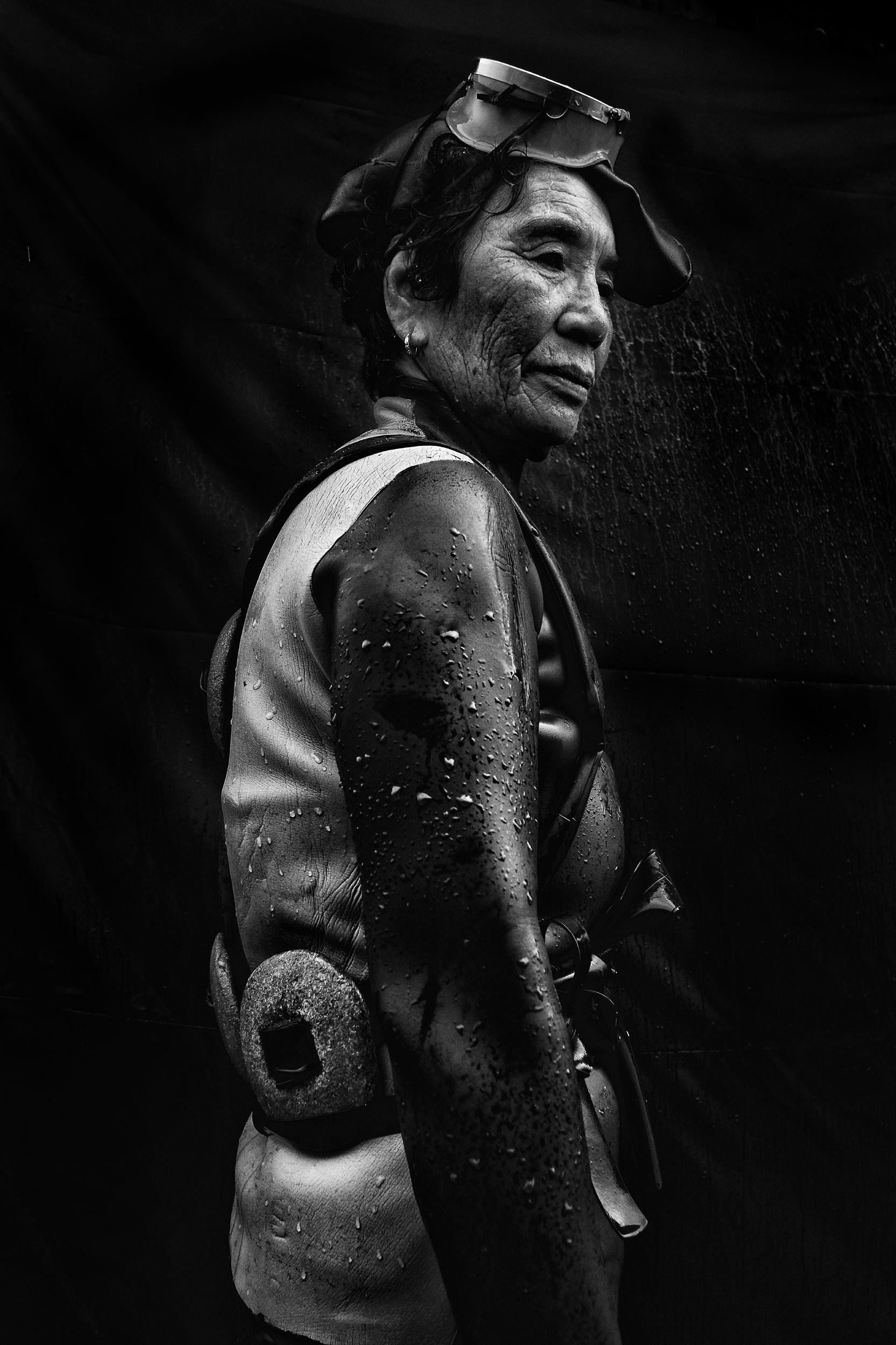
This is such a stunning body of work. Tell us a little about how this experience came about.
The first time I went to Jeju, I saw the Haenyeo coming out of the water in a protected bay with a basalt (volcanic) rock in the distance. I shot with a telephoto lens, and the background was totally black. With the wetsuit, that black on black was visually interesting. That was the start, but it was not the right season so I decided to go back. Then another problem appeared: a tropical storm. Nobody was diving. I waited a week, and with only a few days left, I decided to buy a piece of black cloth and shoot the divers in front of it wherever I could. On one particular day, it was raining quite hard so the ladies were waiting to dive. I had to shoot holding an umbrella. The good news about the rain is that it gives a nice sheen on the neoprene suit!
What was your biggest surprise making this body of work?
The overwhelming majority of Haenyeo are over the age of 60. Most of the ladies I shot were in their late 60s, early 70s. They are free-diving to 15-20 meters, holding their breath for up to two full minutes!
This has been going on for centuries. How does it work today?
This occupation is highly regulated and organized by local fisheries. Divers adhere to strict rules regarding who can dive, when, where, what they can harvest and allotted quantities. It is a difficult, risky lifestyle that is rapidly disappearing as young women choose to pursue other careers. Most of the divers told me they did not encourage their children to dive.
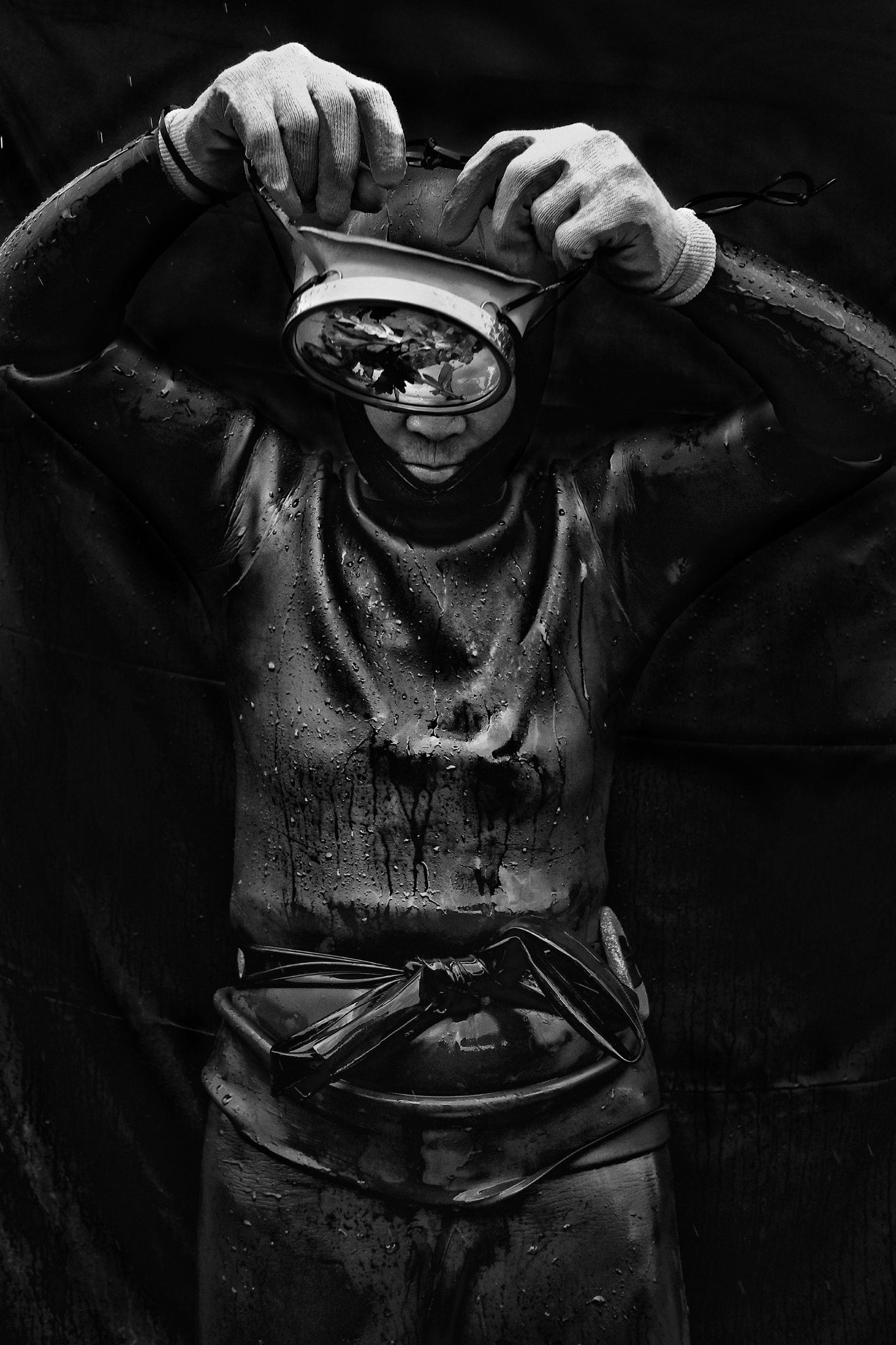
There are still about 4000 ladies who make a living collecting delicacies from the sea. Today, they are celebrated as a national treasure…
What is the role of the Haenyeo women in their community?
Although free diving for seafood has existed for many centuries in Jeju, the practice was taken over by women in the 18th century transforming the region into a semi-matriarchal society. Women were responsible for the most of the household income, but numbers have dwindled since their peak in the 1970s as other opportunities (farming mandarin oranges and developing tourism) offered less arduous working conditions. There are still about 4000 ladies who make a living collecting delicacies from the sea. Today, they are celebrated as a national treasure and inscribed on the UNESCO list of Intangible Cultural Heritage…and they have a dedicated museum in Hado-ri, Gujwa-eup, Jeju, Jeju Island.
…You made these photos in less than 3 minutes each?
I had the vision of the portraits I wanted (black on black in black and white) and I was lucky to get them. I attached the backdrop with ropes and rocks to the side of one of their diving houses (a small structure made of volcanic rocks) because it was very windy. I chose a location that would remain shaded if there was a break in the clouds as I did not want any sun in the pictures. I used a wide-angle lens to go close with a more dramatic effect, and I used low angle shots to make the women appear stronger in the frame. The grey light was perfect to set the mood for the pictures.
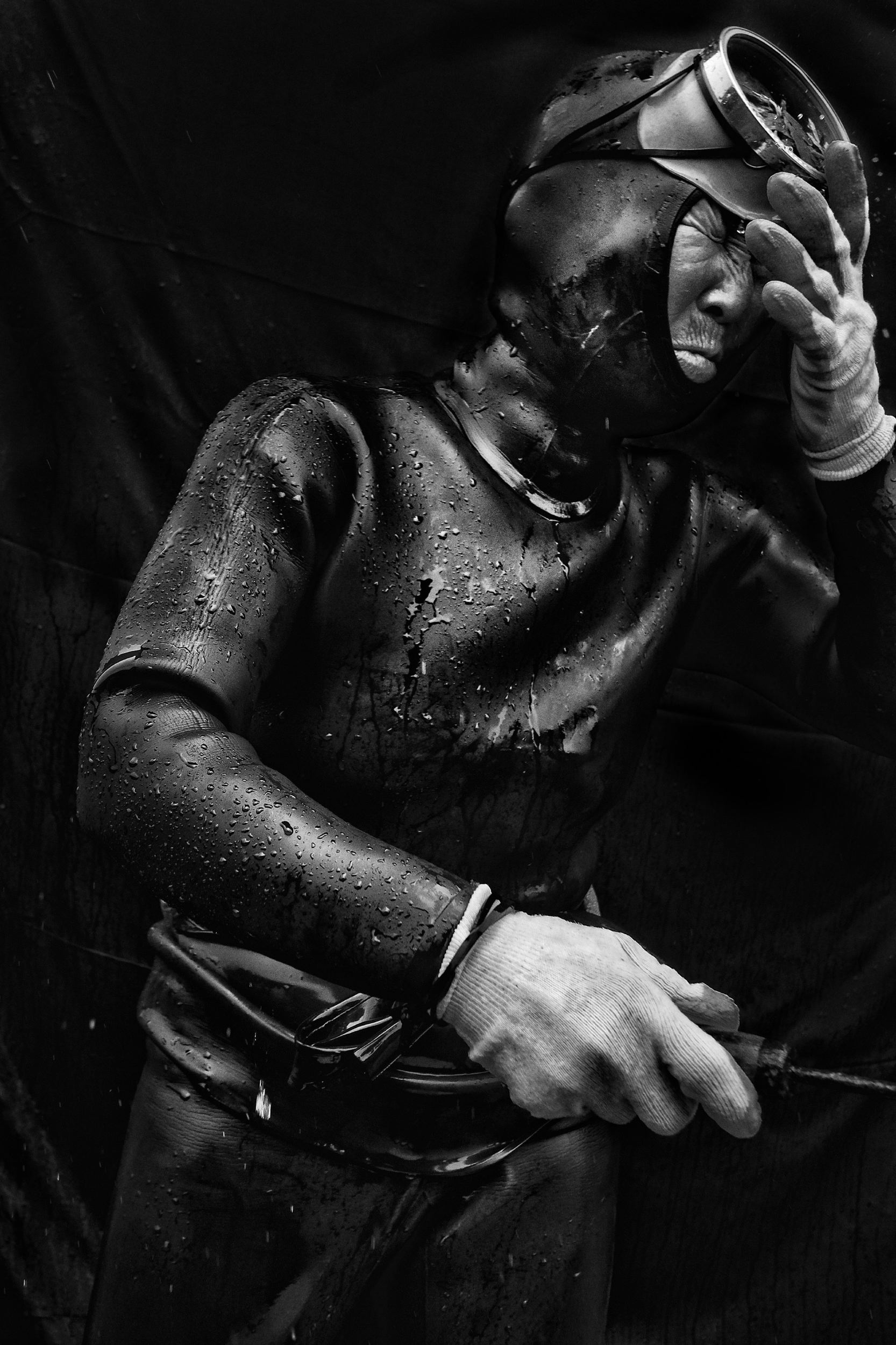
how to catch marine delicacies such as rockfish, sea cucumber, octopus and sea urchin, using a long, sharp instrument called a kkakkuri or golgakji. For more stubborn abalone, a bitchang with a piece of string attached is used to pry this valuable catch from the rocks. ©AlainSchroeder
What did they think of you popping in on them?
Many of them were indifferent. To keep them standing in front of the backdrop long enough to get the shots, I asked my (local) fixer to have them demonstrate their daily gestures of preparation and at the same time respond to questions about their lives. The idea was to keep them busy for a few minutes without just standing there. A few ladies simply refused to participate. It is the first time that people did not react enthusiastically to me taking pictures! I don’t really understand why as I had a young fixer who spoke their dialect and we did not make any cultural mistakes and at the end of the shooting we bought some of their seafood and ate it.
Their days are long. They can spend up to 7 hours a day in the cold water battling currents.
What is a typical day in the life of these women of the sea?
Most of the women have been diving for 30-40 years or even longer. Their days are long. They can spend up to 7 hours a day in the cold water battling currents. Divers are separated by category and only the older, more experienced divers can go further out and deeper. Today, they dive according to the tides and the weather and it is much more regulated than in the past. You can see the difficulty of this lifestyle on their (wrinkled) faces.
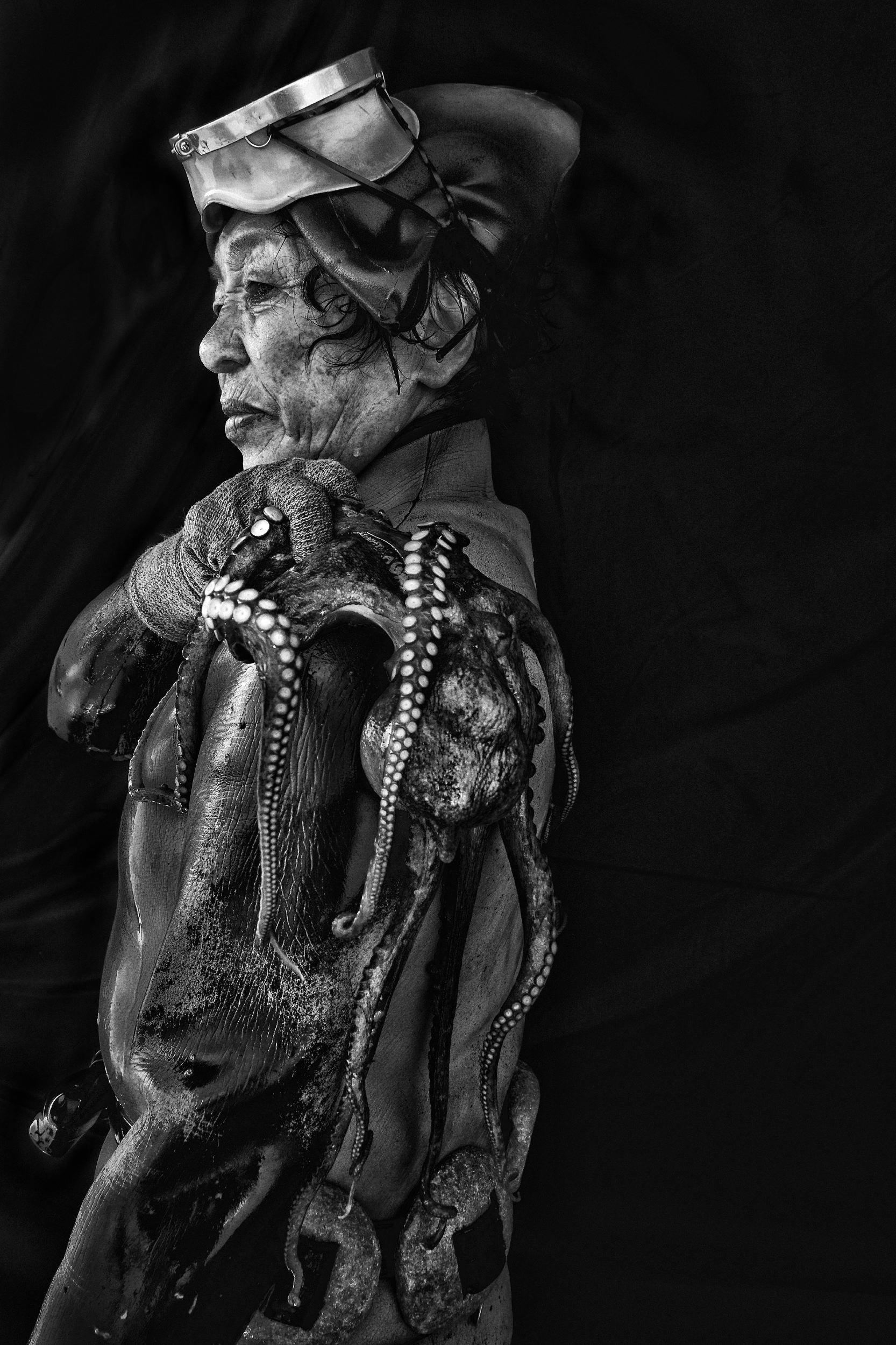
The first time I saw Haenyeos was outside Jeju Airport. Two ladies wearing wetsuits walked by me as I exited the terminal!
Can anyone catch a glimpse of the Haenyeo while visiting Jeju?
You can see (a few) Haenyeo diving almost all year round in one protected bay called Seongsan Ilchulbong where they dive in order to supply seafood to one restaurant for tourists. It is part of the visit to the Seongsan Ilchulbong sunrise peak, an extinguished volcano (on UNESCO World list).
There are Haenyeo houses in every town. In the summer months, when the weather is good, chances are you will see them coming back with their catch or simply walking in the streets with their gear. The first time I saw Haenyeos was outside Jeju Airport. Two ladies wearing wetsuits walked by me as I exited the terminal!
Your life right now seems like a bit of a dream (to me).
I would not call it a dream, but rather a well-planned reality. I was the co-founder and co-owner of a photo agency in Brussels, Belgium, and around 2000, business was getting harder due to the internet and the rise of digital cameras (both great things, in fact). Competition became tougher and more diverse, not only from other agencies but almost anybody could sell or try to sell pictures…Magazines no longer offered assignments or guarantees, and we were forced to explore other sources of revenue like corporate communications and video. In 2012, I sold my shares of my company in order to travel the world and shoot personal projects focusing on social issues and human interest stories.
As a photographer, I like to tell stories in a personal, visual way. In Belgium, we have a background of surrealist artists (Magritte, Delvaux) plus the strong influence of the French surrealists. They definitely shaped the way I see things.
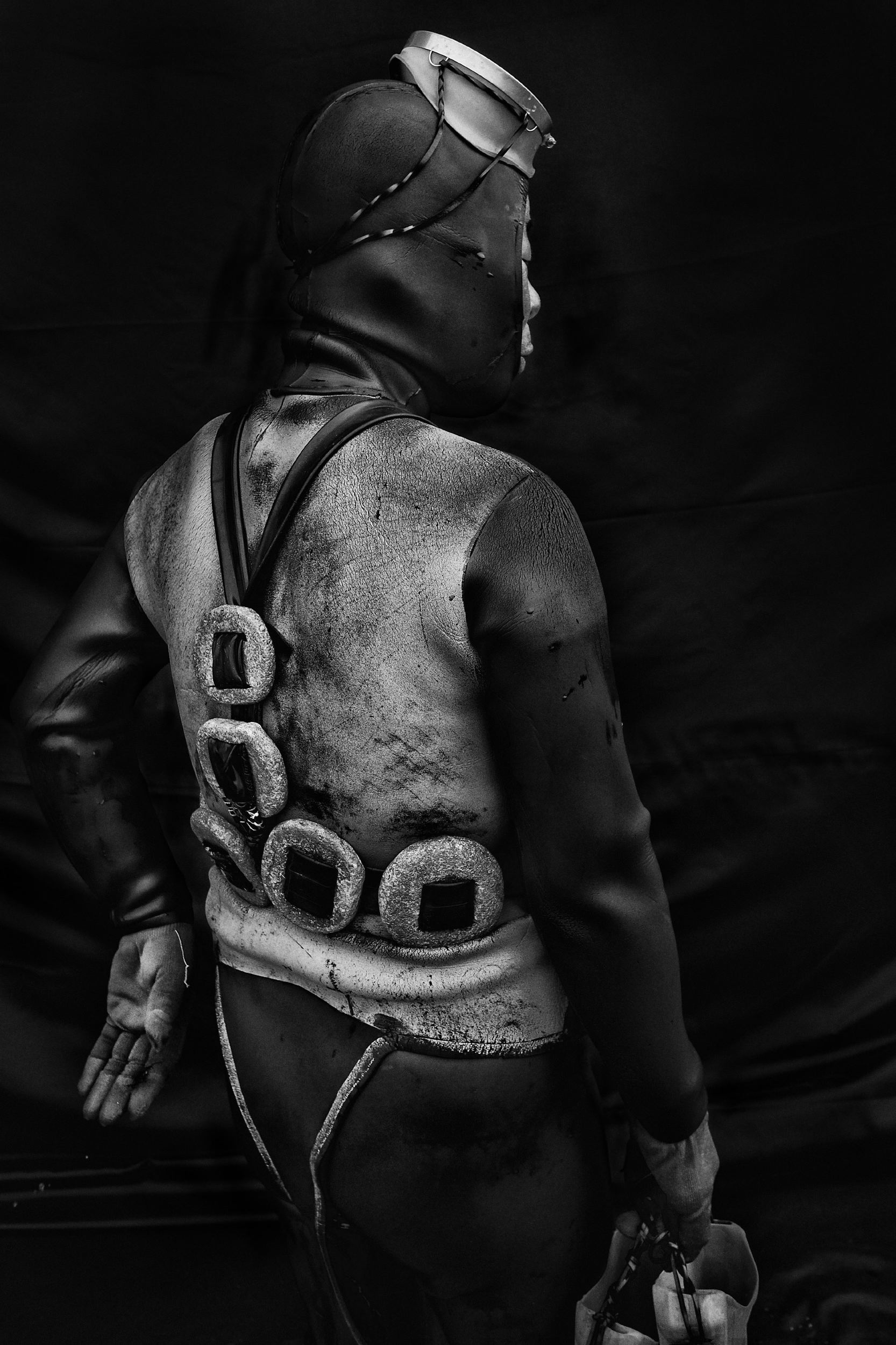
In order to make this lifestyle change, I spent several years organizing my departure.
Your photo trips can last as long as 3 weeks to 6 months. How do you make this kind of lifestyle possible?
You have to want to live this type of lifestyle. I started to travel long distances at the age of 18 (in 1974), hitchhiking from Belgium to Afghanistan on a shoestring budget, and I was hooked. In order to make this lifestyle change, I spent several years organizing my departure. I have been traveling for almost 8 years now. Let‘s say that I am a good investor.
Do you plan on “retiring”?
As long as my health is fine, I will continue to travel. And so far I have no signs of boredom. I am still excited to discover new countries, people, and customs.
Where to next?
Armenia, Azerbaijan, Poland.
Alain Schroeder is a Belgian photojournalist born in 1955. In 1989, he founded Reporters (http://www.reporters.be), a well-known photo agency in Belgium. He has illustrated over thirty books dedicated to China, Persia, the Renaissance, Ancient Rome, the Gardens of Europe, Thailand, Tuscany, Crete, Vietnam, Budapest, Venice, the Abbeys of Europe, Natural Sites of Europe, etc. Belgian titles include, « Le Carnaval de Binche vu par 30 Photographes », and « Processions de Foi, Les Marches de l’Entre-Sambre-et-Meuse ». Publications include National Geographic, Geo, Paris-Match.
He has won many international awards including a Japan Nikon Award 2017 for the Rohingya series, the TPOTY Travel Photographer of the Year Award 2017 with the series Living for Death and the series Kushti, and 1st prize at World Press Photo 2018 for the series Kid Jockeys in the category Sports Stories.
The ideas expressed here are solely the opinions of the author and are not researched or verified by AGEIST LLC, or anyone associated with AGEIST LLC. This material should not be construed as medical advice or recommendation, it is for informational use only. We encourage all readers to discuss with your qualified practitioners the relevance of the application of any of these ideas to your life. The recommendations contained herein are not intended to diagnose, treat, cure or prevent any disease. You should always consult your physician or other qualified health provider before starting any new treatment or stopping any treatment that has been prescribed for you by your physician or other qualified health provider. Please call your doctor or 911 immediately if you think you may have a medical or psychiatric emergency.


